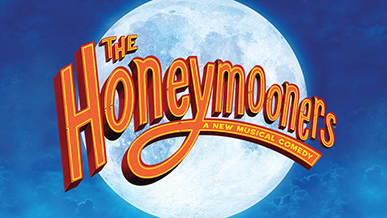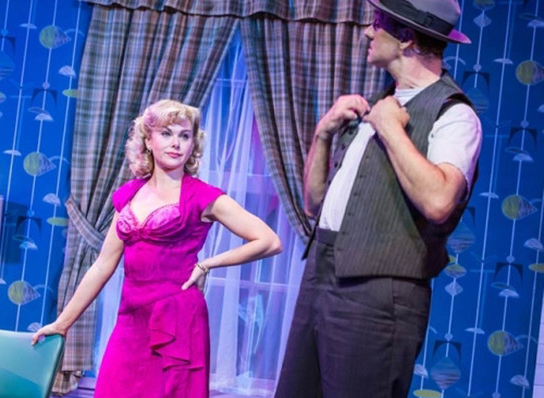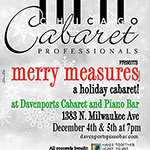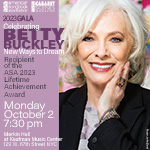The Honeymooners
Paper Mill Playhouse, Millburn, NJ , October 13, 2017
Reviewed by Chip Deffaa for Cabaret Scenes
 Paper Mill Playhouse is presenting, through October 29th, the world premiere of a new musical: The Honeymooners, based on the famed television show starring—in its best-remembered incarnation—Jackie Gleason as bus driver Ralph Kramden, Art Carney as sewer-worker Ed Norton, and Audrey Meadows and Joyce Randolph as their wives, Alice and Trixie. There is a good bit to enjoy in this amiable but uneven musical comedy. There are even some moments of brilliance. But, there are also times, alas, when the show feels obvious and plodding. If it hopes to successfully transfer to Broadway—and I’d like to see that happen—it will need some work.
Paper Mill Playhouse is presenting, through October 29th, the world premiere of a new musical: The Honeymooners, based on the famed television show starring—in its best-remembered incarnation—Jackie Gleason as bus driver Ralph Kramden, Art Carney as sewer-worker Ed Norton, and Audrey Meadows and Joyce Randolph as their wives, Alice and Trixie. There is a good bit to enjoy in this amiable but uneven musical comedy. There are even some moments of brilliance. But, there are also times, alas, when the show feels obvious and plodding. If it hopes to successfully transfer to Broadway—and I’d like to see that happen—it will need some work.Writers Dusty Kay and Bill Nuss have created a serviceable book that often recalls fondly remembered bits from the classic sitcom. The script is sprinkled with familiar Honeymooners catch phrases (“One of these days….,” “To the moon, Alice!,” “Baby, you’re the greatest”). We briefly see, in welcome nods to the original television series, Norton watching his beloved Captain Video on TV, or warming up at the piano by playing “Old Folks at Home.” And we chuckle, happy to be briefly reminded of some great vintage television bits.
The plot is intriguing enough. Kramden and Norton enter a jingle-writing contest for Faciamatta’s Mozzaroni Cheese. They land jobs with a Madison Avenue ad agency. Trixie, meanwhile, wins a job singing and dancing at the noted nightclub El Morocco. And the musical has us asking: Will success change the Kramdens and the Nortons?
I don’t envy anyone faced with the challenge of adapting, directing, or starring in a stage production of this iconic television show. You need to create a show that feels familiar without feeling predictable or formulaic. You need to add songs that, hopefully, will be appealing, memorable, and feel right for these beloved characters. You’re inevitably going to be compared with—judged against—one of the greatest of all TV sitcoms, a series that was, in its prime, perfectly written, cast, and performed. It’s very rare to have all of the elements fall into place as perfectly as they did for Gleason and company in 1955-56, when the 39 classic Honeymooners episodes that so many know and love were originally televised. There was a rare magic to them that even Gleason found impossible to fully recapture. From the late 1950s through the 1970s, he periodically revived the show in one form or another, without ever really hitting the heights of the original episodes which have been re-broadcast countless times; they’ve achieved an enduring popularity that the later revivals have not duplicated.
It was exciting for me, in 1966, when Gleason began presenting—in color—brand new hour-long musical episodes of The Honeymooners (with new actresses playing Alice and Trixie). And, in the 1970s, Gleason revived it still again, in TV specials. I watched all of those incarnations back then, always hoping for the best, always finding a good deal to enjoy—but also sometimes feeling vaguely disappointed, because these later attempts generally did not land quite as well as the originals had. And changing a cast member or two weakened the chemistry.
Sitting in the audience at Paper Mill the other night, I felt almost like I was watching one of those later incarnations, where there were moments that worked well, and other moments where I felt vaguely cheated, where I sorely missed the magic and the very special chemistry that the original cast members had. Sometimes the songs worked. Sometimes, however, they felt more like padding. (For example, having fellow bus drivers sing, at some length, that they believe Ralph Kramden’s bubble will soon burst, because they all know his big dreams of success never really come true, does not work better than having one person utter a spoken zinger would have. As the bus drivers were singing about how Ralph was bound to fail, I was thinking, “Point made; now let’s move on. You’re slowing down the show.”)
Here are some things I liked about this production: The actor I saw in the lead role of Ralph Kramden—Michael L.Walters—offered about as good an imitation of Jackie Gleason playing Kramden as you could ever hope to see. He had the look, the voice, the inflections. It was almost like watching Gleason. (Walters’ bio says he is a “noted impersonator of Jackie Gleason and Dame Edna.” ) Now, Walters happens to be the understudy; he was going on, at the performance I attended, for Michael McGrath. But Walters did an excellent Gleason impersonation. And the chemistry between Walters and Leslie Kritzer—who was terrific as Alice Kramden—was very good. You could open the show on Broadway with Walters and Kritzer in the leads, and audiences would embrace them. Walters gave about as satisfying a performance by an understudy as I’ve ever seen. He played Kramden with relish. And I enjoyed that.
I thought Michael Mastro, whom I’ve loved in so many other Broadway shows (Side Man, 12 Angry Men, Cat on a Hot Tin Roof, Judgement at Nuremberg, Love! Valour! Compassion!) was miscast as Ed Norton. Mastro is an excellent dramatic actor—a favorite of mine since his unforgettable work in Side Man. But he didn’t have the goofy, sappy, endearing quality the role requires. He didn’t display a great feel for the kind of comedy that The Honeymooners features. And, I didn’t feel the deep bond I should have felt between his Norton and Walters’ Kramden.

Laura Bell Bundy was fine as Trixie; but again, I didn’t feel the chemistry I should have between Trixie and that of Alice.
The performance I enjoyed the most—it’s worth the price of admission just to see him—was given by Lewis J. Stadlen in a supporting role as Old Man Faciamatta, head of the cheese company. He took ownership of the stage the moment he walked on—old-school showmanship at its best. The others in the show were good, but he was great. Stadlen’s not on stage a long time. But what presence! And he moved around the stage in the musical number “Infine la Felicita” with a wondrously whimsical poetic grace, evoking for a moment—just through movement—Groucho Marx (whom he portrayed so unforgettably, years ago, in Minnie’s Boys.)
Lewis Cleale—perfectly cast as a back-stabbing Madison Avenue advertising exec—was also impressive. Again, he did not have a whole lot to do, but he commanded attention, and sang surely and strongly.
The show, I might add, boasts a terrific surprise ending. And the TV commercial that Kramden and Norton create, near the end of the show, is hilarious.
But The Honeymooners, at its best on TV, could sometimes be quite poignant, not just funny. Gleason, Carney and company were as expert at creating pathos as humor. They moved us. And this musical comedy needs a bit more pathos. I chuckled at times. But I did not feel moved.
To be a truly great musical you have to have a great score. This score is hit-and-miss. (Some numbers are delicious and serve the show perfectly; others seem all too obvious.) The lyrics (by Peter Mills, whose work I’ve long appreciated) are generally stronger than the music (by Stephen Weiner). Sometimes you have very clever lyrics set to rather ordinary melodies. Some of the melodies, I might add, are not as memorable as the music heard, in passing, in the original TV series. I wish a way could be found to include the familiar theme song (“You’re My Greatest Love”) that Jackie Gleason composed for The Honeymooners. If you included it somewhere in the show—whether as instrumental underscoring or as a song for Kramden to sing to Alice—it could only help. (Gleason created the melody. And there are also little-known lyrics, by William Templeton, which aren’t bad.) Gleason’s own compositions often had a touch of sadness. And they had character. (His “Melancholy Serenade” was more memorable than any melody I heard in this show.)
There’s a good deal to enjoy in this stage production at present. But, I think, with a little additional development, could become far more satisfying. I’d like to see that.





